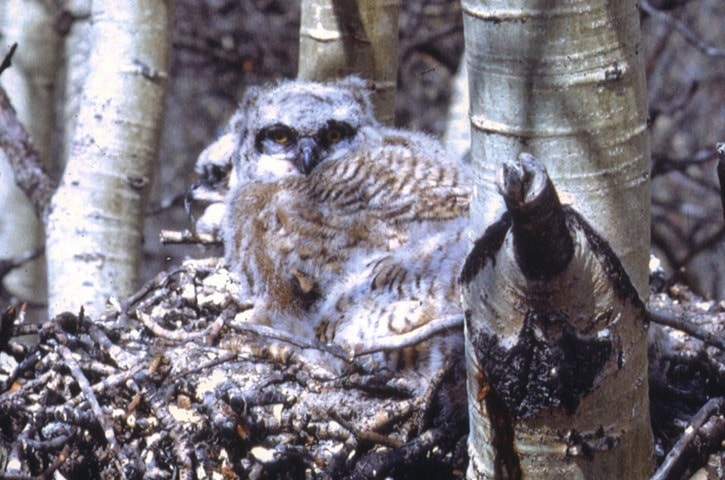From 30 feet up in a poplar tree and standing with both feet firmly lodged next to the trunk on two limbs, I was about eye level with a great horned owl’s nest, just a few feet away in another tree. It was March and I could plainly see one egg in the nest as the adult owl had left the nest, landing in another poplar tree very close by. When I had about reached the level of the nest, the parent owl, with clacking beak, stared at me defensively. Even with a hardhat protecting my head, I was still ready to protect my face should it fly at me. The owl had a perfect right to be defensive because I was an intruder in its territory, and, not only that, I was right on its doorstep.
When “perched” in the tree, I generally had only one hand free to work the camera unless I wrapped one leg around the tree. Since I was barely eye-level with the top of the nest, with my old styled camera, it was difficult to get what I wanted. Now, with digital cameras, one can get better pictures in awkward positions. A few feet can be gained by holding the camera, with one hand, above the head, pointing it where one thinks it should be. A dozen pictures can be shot from different positions and one is sure to get at least one good photo, all with one hand.
Great horned owls, like other owls, such as pygmy and saw-whet owls, both indigenous in the Kootenays, nest much earlier than other birds, excepting gray jays and horned larks. Horned owls often nest in March, but have, in some areas, been known to begin in January. Owls, as most of you know are primarily active at night so the increased length of day doesn’t directly determine breeding season, as in songbirds. However, the hatching somewhat corresponds to when small rodents and other prey become active, thus, in that respect, assuring adequate food.
Throughout the egg laying, incubating and hatching events, I was up my observation tree a number of times to observe the progress. Of course, the poplar trees were leafless until about the time the chicks hatched. The nest wasn’t very concealed to anyone looking up and neither was I. One time a little later, when up the tree, I heard voices of children somewhere along the fence line, dividing the acreages. I was hoping they would diverge off somewhere else, but they didn’t. In several minutes three early grade-school girls came ambling along the barbwire fence. Again, I was hoping they wouldn’t see me up the tree. I wasn’t sure if I should let them know about my presence so when they did see me they wouldn’t be frightened. But, then, I thought my calling might scare them and I didn’t want that to happen. So I just kept still and quiet.
They didn’t spot me but they did spot one of the adult owls. Then things changed. One said, “Oh, look.” Another said, “That’s an owl.” And, after some intense looking at the owl perched nearby, another said, “Let’s go.” Quietly they turned and left. I was relieved when they left but at the same time felt bad because they seemed to have this unrealistic fear of owls that barred them from becoming further acquainted with this basically harmless owl.
Owl nests, like those of pygmy and saw-whet, are usually in tree cavities thus are a bit more protected than are nests of great horned owl. Ravens often harass daytime-roosting owls in deciduous trees, especially before they are leafed out. Great horned owls also nest in coniferous trees, staying quite concealed, in the daytime, in the upper branches of tall Douglas fir trees in residential areas. The only way a few people learn that they have owls for neighbors is if, when out at night, they happen to hear them hooting.
Great horned owls, residing in residential areas and relying totally on town prey would have to be pretty opportunistic when it comes to food. Who knows what they might catch! I am sure they venture from those protective groves of Douglas fir trees over to nearby parks, hedgerows and fields. There they might find their more natural, mouse menu. I have seen them prey on young varying hare. Larger adults can lift an adult hare off the ground but if the prey is too heavy for them, they may apt to eat it on the spot, if they are not endangered. It’s rare that a great horned owl will take on a cat but in some regions they are known as “cat owls” or “winged tiger”. It would take a lot for a smaller adult owl to get it off the ground. Even one owl I saw, with a small hare, seemed to struggle to get airborne. A pygmy owl I once watched, dropped its mouse, picked it up again, flew to a shed roof and then up to a wire where it ate its catch.
If there aren’t baby owls in the nest by now, there soon will be within weeks. At 10 weeks, babies may be quite vocal, giving a single, usually unidentified, shriek. In their language that says, “Food!” Great horned owls are quite ubiquitous. You may have a nest in your neighborhood. They most often reveal their presence by the characteristic hoot. The pygmy owl says, “I am here,” by single-noted flutelike calls. Now you can find some owls!
Here is something for further thought. “The wise old owl lived in an oak. The more he saw the less he spoke. The less he spoke, the more he heard. Why can’t we all be like that wise old bird?”
Ed McMackin is a biologist by profession but a naturalist and hiker by nature. He can be reached at 250-866-5747.
